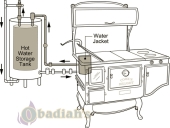Hi, I am building a tiny house and I am aiming to incorporate a hot water system that relies on solar and wood fired heating to heat the water. This works by convection. The cold water supplies a hot water tank positioned above the wood stove. The cold water will cycle into the wood stove where it will be heated. The water then rises back into the top of the storage tank and will continue this cycle to create free hot water. This process is called thermosiphoning. I have drew some preliminary sketches and was curious if anyone had any suggestions, tips, advice, or see any flaws with this set-up. A couple questions I have are:
Will I need a pump to relay the hot water through the plumbing to the fixtures? I imagine that heat will produce enough pressure to push the water through the lines..is this true?
Will the hot water lines feeding to the fixtures need to re-enter the system? In my drawing it just ends at the kitchen sink..will I need to plumb this back in to the thermosiphon loop? Or will it be safe the way that it is.
Notes on the drawing: This is an overhead view of how the system will run through the tiny house. The top of the drawing runs along the right side of the house with most of the lines running through the cabinetry. It will then run along the front of the house (still in cabinetry) before entering the shower room (at the left of the house)where I was hoping the lines would rise up to the ceiling while running through the room and exit through the wall. It would then enter the storage tank located in a closet near the woodstove. The storage tank will be about 4 feet off the floor and the woodstove will be about 18 inches above the floor. I hope this helps. I would love to hear your thoughts! If you have any questions please let me know! Thank you all for your time

.
If you would like to learn more about this system please see a previous forum on the matter found here:
https://permies.com/t/47521/wood-burning-stoves/Wood-fired-passive-gravity-fed#379982




 .
.
![Filename: Sketch111205755-1.png
Description: [Thumbnail for Sketch111205755-1.png]](/t/52941/a/35562/Sketch111205755-1.png)
















 .
. 1
1




 1
1




 !
!









